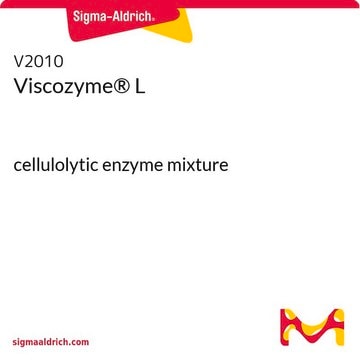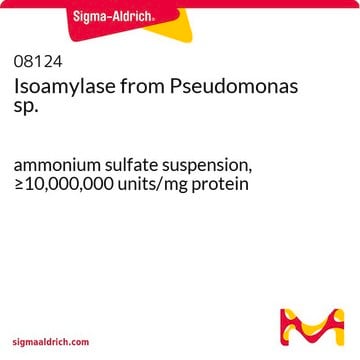22178
Cellulase from Aspergillus niger
powder, off-white, ~0.8 U/mg
Synonym(s):
1,4-(1,3:1,4)-β-D-Glucan 4-glucanohydrolase
Sign Into View Organizational & Contract Pricing
All Photos(1)
About This Item
Recommended Products
biological source
Aspergillus niger
form
powder
specific activity
~0.8 U/mg
color
off-white
storage temp.
2-8°C
Looking for similar products? Visit Product Comparison Guide
Related Categories
General description
Cellulase is a member of glycoside hydrolase family and is produced by a number of cellulolytic microbes.
Application
Cellulase from Aspergillus niger has been used:
- in the preparation of the standardized solution to determine absolute cellulase levels
- in phosphate-citric acid buffer for activity assay
- in non-starch polysaccharide degrading enzyme cocktail for in vitro hydrolysis of defatted rice bran and in the approach to improve the nutritive value of poultry feed
Biochem/physiol Actions
Cellulase from Aspergillus niger catalyzes the hydrolysis of endo-1,4-β-D-glycosidic linkages in cellulose, lichenin, barley glucan, and the cellooligosaccharides cellotriose to cellohexaose. It does not cleave cellobiose or p-nitrophenyl-β-D-glucoside. This enzyme will also cleave intact glycosaminoglycan from a core peptide by hydrolyzing the xylosyl serine linkage.
Unit Definition
1 U corresponds to the amount of enzymes which liberates 1 μmol glucose from carboxymethylcellulose per minute at pH 5.0 and 37°C
Other Notes
View more information on enzymes for complex carbohydrate analysis at www.sigma-aldrich.com/enzymeexplorer
Signal Word
Danger
Hazard Statements
Precautionary Statements
Hazard Classifications
Resp. Sens. 1
Storage Class Code
11 - Combustible Solids
WGK
WGK 1
Flash Point(F)
Not applicable
Flash Point(C)
Not applicable
Personal Protective Equipment
dust mask type N95 (US), Eyeshields, Gloves
Certificates of Analysis (COA)
Search for Certificates of Analysis (COA) by entering the products Lot/Batch Number. Lot and Batch Numbers can be found on a product’s label following the words ‘Lot’ or ‘Batch’.
Already Own This Product?
Find documentation for the products that you have recently purchased in the Document Library.
Customers Also Viewed
A novel system for trigger-controlled drug release from polymer capsules
Fluri David A, et al.
Journal of Controlled Release : Official Journal of the Controlled Release Society, 131(3), 211-219 (2008)
Frank Rhein et al.
Water research X, 17, 100155-100155 (2022-10-01)
Microplastic particles (MP) are efficiently retained in wastewater treatment plants and enriched in sewage sludge. For monitoring MP contents in wastewater systems, sewage sludge is thus well suited, but also requires an isolation of MP from the sludge matrix, as
Thalita Regina Tuleski et al.
Scientific reports, 9(1), 4041-4041 (2019-03-13)
Three species of the β-Proteobacterial genus Herbaspirillum are able to fix nitrogen in endophytic associations with such important agricultural crops as maize, rice, sorghum, sugar-cane and wheat. In addition, Herbaspirillum rubrisubalbicans causes the mottled-stripe disease in susceptible sugar-cane cultivars as
María Dolores Ayala et al.
Animals : an open access journal from MDPI, 10(12) (2020-12-05)
A 90-d feeding trial was conducted in which five groups of gilthead seabream (11.96 g initial body weight) were fed with a microalgae-free diet (control group, C) or four diets containing the microalgae Nannochloropsis gaditana at two inclusion levels (2.5%
The use of surrogate standards as a QA/QC tool for routine analysis of microplastics in sewage sludge.
Philipp, et al.
The Science of the Total Environment, 835, 155485-155485 (2022)
Our team of scientists has experience in all areas of research including Life Science, Material Science, Chemical Synthesis, Chromatography, Analytical and many others.
Contact Technical Service








